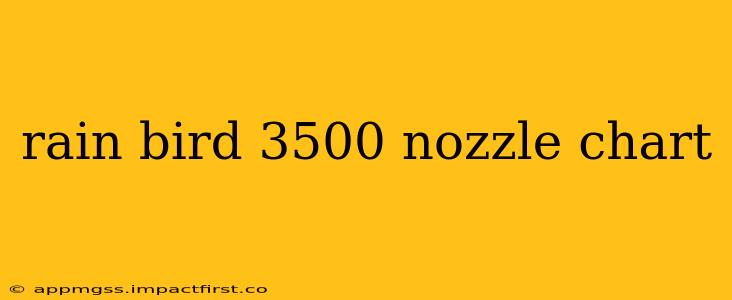The Rain Bird 3500 series rotary nozzles are a popular choice for irrigation professionals and homeowners due to their reliability, efficiency, and wide range of spray patterns. Understanding the Rain Bird 3500 nozzle chart is crucial for proper sprinkler system design and maintenance. This guide will break down the chart, explain its key features, and answer common questions.
Understanding the Rain Bird 3500 Nozzle Chart
The Rain Bird 3500 nozzle chart isn't a single, universally accessible document. Instead, it's represented within various Rain Bird resources, including their official website and catalogs. The chart details the performance characteristics of each nozzle within the 3500 series. Key information typically included is:
-
Nozzle Size: Expressed as a fraction (e.g., 4.0, 5.0, 6.0), this denotes the nozzle's orifice size and directly impacts the flow rate and throw distance. Larger numbers generally mean higher flow and throw.
-
Precipitation Rate (inches per hour): This indicates how much water the nozzle delivers to the area it covers in an hour. Consistent precipitation rates across zones are vital for even watering.
-
Throw Distance (feet): This specifies the radius of the water spray pattern. Knowing the throw distance is essential for proper spacing of sprinklers to ensure complete coverage without overlap or gaps.
-
Arc (degrees): This shows the angle of the spray, ranging from partial circles (e.g., 90, 180 degrees) to full circles (360 degrees). Choosing the correct arc is crucial for efficiently watering specific areas.
What Factors Affect Nozzle Performance?
Several factors influence how effectively a Rain Bird 3500 nozzle performs:
-
Water Pressure: Higher pressure usually leads to greater throw distance and precipitation rate, but excessive pressure can damage the nozzle or cause uneven watering. Optimum pressure is crucial.
-
Nozzle Type: The 3500 series offers various nozzle types (e.g., PRS, MP Rotator) each having a different spray pattern and precipitation rate.
-
Elevation: Sprinklers installed on slopes or uneven terrain will have altered throw distances compared to those on level ground.
How to Read a Rain Bird 3500 Nozzle Chart
While the chart itself isn't a single document, understanding how to interpret the data within any Rain Bird resource is key:
-
Identify the nozzle type: Determine whether you are working with a Rain Bird PRS (Precision Rotor), MP Rotator, or other 3500 series nozzle.
-
Find your desired throw distance: Based on your landscape's design and sprinkler spacing, select the appropriate nozzle size with the desired throw distance.
-
Check the precipitation rate: Ensure the selected nozzle provides a suitable precipitation rate for your specific needs and plant types. Uniform precipitation is crucial.
-
Choose the appropriate arc: Select an arc to match the area you need to water. A full circle arc (360) is not always optimal.
-
Consider pressure: Remember the impact of water pressure on throw and precipitation rate. Your system should provide the recommended pressure for the chosen nozzle.
What is the difference between Rain Bird PRS and MP Rotators?
Rain Bird offers two main nozzle types within the 3500 series: PRS and MP Rotator. They differ significantly in their water application methods:
-
PRS (Precision Rotor): PRS nozzles deliver water in a rotating spray pattern. They're typically used for larger areas and offer a good balance between throw distance and precipitation rate.
-
MP Rotator: MP Rotators use a multi-trajectory spray pattern, resulting in slower rotation and a more efficient, water-conserving application. They're ideal for areas requiring gentle watering or for sensitive plants.
How do I choose the right nozzle for my needs?
Selecting the right nozzle depends on various factors, including:
- Area to be covered: Determine the size and shape of the area you need to irrigate.
- Type of plants: Different plants have different water requirements.
- Soil type: Soil type influences how quickly water is absorbed.
- Water pressure: This significantly impacts nozzle performance.
- Desired precipitation rate: Aim for a uniform precipitation rate across all zones.
Consult Rain Bird's resources or contact a professional irrigation specialist for tailored guidance.
Where can I find a Rain Bird 3500 nozzle chart?
The most reliable source for Rain Bird 3500 nozzle charts and specifications is the official Rain Bird website. Their catalog and product information pages usually contain detailed information on the various 3500 series nozzles. Contacting a local Rain Bird distributor is another option for access to these vital resources.
By carefully considering these factors and consulting the appropriate Rain Bird resources, you can effectively use the information provided to ensure optimal performance from your Rain Bird 3500 sprinkler system. Remember, proper sprinkler design and maintenance are key to a healthy and efficient irrigation system.
